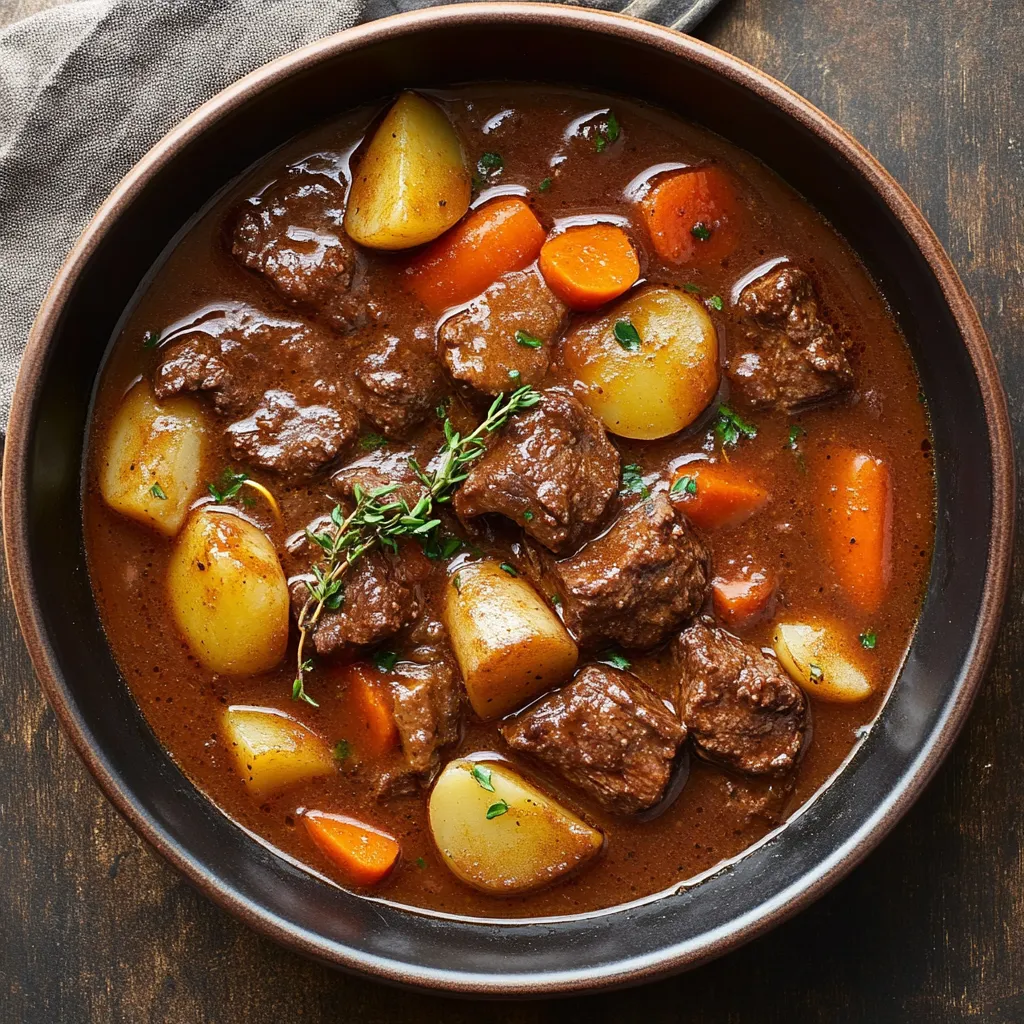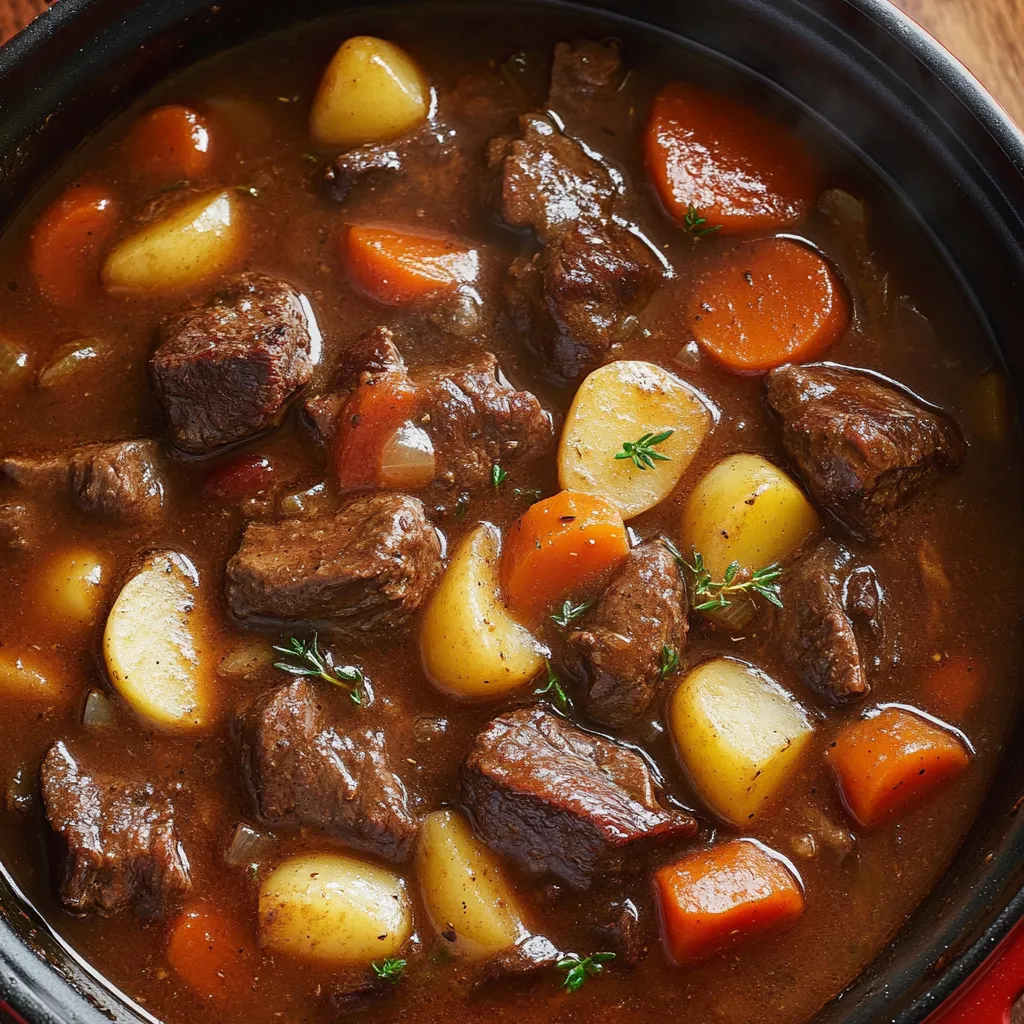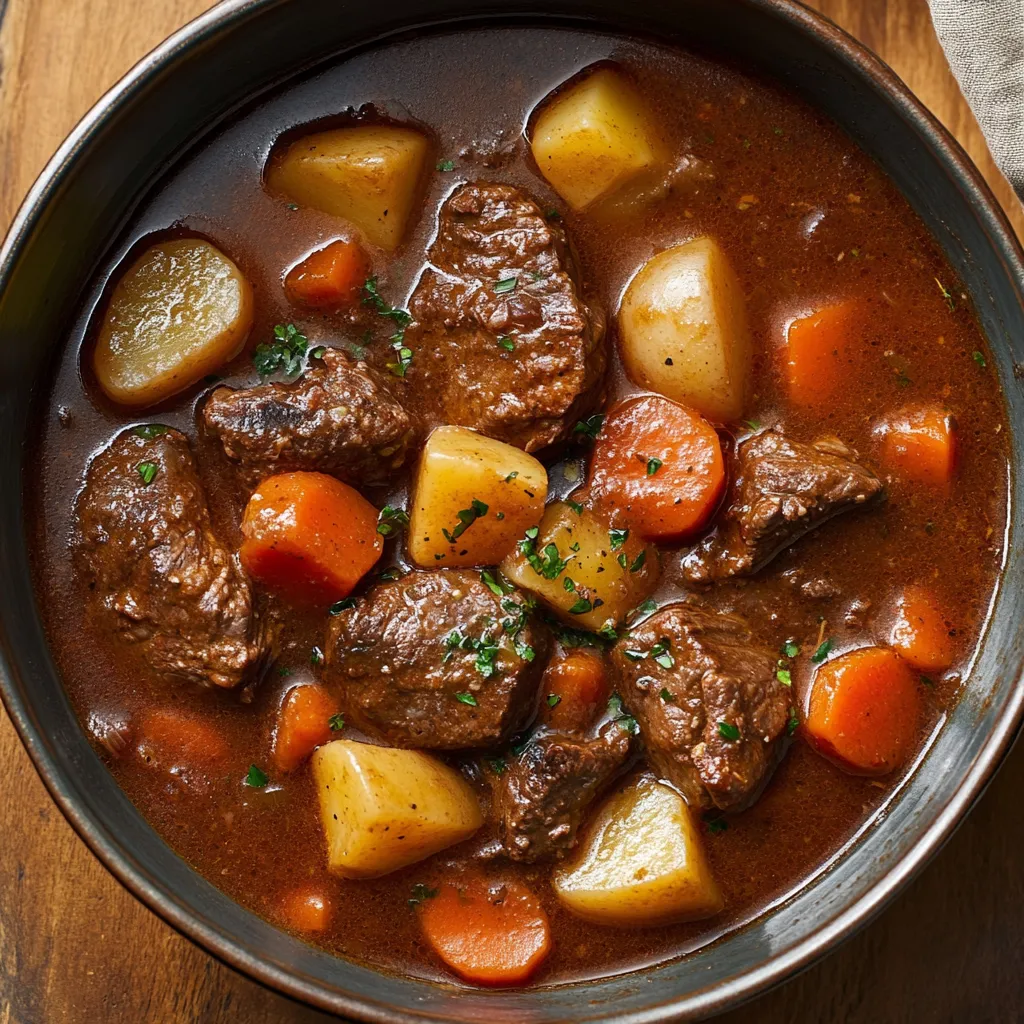 Pin it
Pin it
This Guinness beef stew has become my absolute favorite cold-weather meal because the combination of tender beef, rich beer broth, and hearty vegetables creates comfort food that's worth every minute of the slow cooking process. The Guinness adds incredible depth and complexity without making it taste boozy, transforming ordinary beef stew into something special enough for St. Patrick's Day celebrations. I started making this about six years ago when I wanted something more interesting than regular beef stew, and now my family requests it throughout the entire winter, not just in March.
My husband grew up eating his grandmother's plain beef stew and was skeptical about adding beer, but after one bite he declared this the best stew he'd ever had. Watching him go back for thirds on a Sunday afternoon while snow falls outside feels like the definition of cozy winter perfection.
Ingredients You'll Need
- All-purpose flour: (about half a cup for dredging) - Coats the beef and helps it brown beautifully while also thickening the stew later
- Salt and black pepper: (for seasoning throughout) - Essential at multiple stages for building layers of flavor
- Vegetable oil or canola oil: (for browning) - Needs a high smoke point for searing meat properly
- Boneless beef chuck: (about 2 to 3 pounds, cut into chunks) - The best cut for stewing because it becomes incredibly tender; grass-fed is ideal but use what's available
- Fresh garlic: (several cloves, minced) - Adds aromatic depth that garlic powder simply cannot provide
- Tomato paste: (a few tablespoons) - Contributes rich umami flavor and helps create deep color in the broth
- Apple cider vinegar: (about a tablespoon) - Brings brightness and helps tenderize the meat; red wine vinegar substitutes
- Guinness beer: (one full bottle or can) - Creates the signature flavor; you could use red wine instead but the taste will be different
- Beef broth or stock: (about 3 to 4 cups) - Forms the liquid base; bone broth adds even more richness
- Fresh herbs: (bay leaves, fresh thyme, fresh rosemary, and parsley) - Add complexity and brightness that dried herbs can't match
- Brown sugar: (just a tablespoon) - Balances flavors without making it sweet
- Onions, potatoes, and carrots: (several of each, cut into chunks) - Provide substance and soak up all that delicious broth
- Cornstarch: (for thickening at the end) - Creates that perfect gravy consistency
Step-by-Step Instructions
- Dredge and brown the beef in batches:
- Place your flour in a shallow bowl and season it generously with salt and pepper, mixing it together with a fork. Pat your beef chunks completely dry with paper towels, then toss them in the seasoned flour, coating all sides and shaking off any excess. Heat a large Dutch oven over medium-high heat with a couple tablespoons of oil until it shimmers, then add about a third of your beef chunks in a single layer with space between them. Let them sear undisturbed for three to four minutes until deeply browned on the bottom, then flip and brown the other sides. Transfer the browned beef to a plate and repeat with remaining beef in batches, adding more oil as needed. Don't rush this step or crowd the pan because proper browning is what creates incredible flavor.
- Build the flavor base with tomato paste and Guinness:
- Once all your beef is browned and set aside, add the tomato paste directly to the hot Dutch oven and cook it for about a minute, stirring constantly, until it darkens slightly and becomes fragrant. This cooking step removes any metallic taste and intensifies the tomato flavor. Pour in your apple cider vinegar followed immediately by the entire bottle of Guinness, then use a wooden spoon to scrape all those beautiful browned bits stuck to the bottom of the pot vigorously. Those bits are pure concentrated flavor, so make sure you get them all incorporated into the liquid. Let the mixture bubble and reduce slightly for about two minutes.
- Add beef and broth for initial simmering:
- Return all your browned beef and any accumulated juices back to the pot, then pour in your beef broth until it just covers the meat. Add your bay leaves, fresh thyme sprigs, fresh rosemary sprigs, minced garlic, and another good pinch of salt and pepper. Bring everything to a rolling boil over high heat, then immediately reduce the heat to low and partially cover the pot with the lid slightly askew. Let it simmer gently for two full hours, stirring occasionally and checking that it's not boiling too vigorously. The beef should become increasingly tender as it cooks in that flavorful liquid.
- Add vegetables and continue cooking:
- After two hours of simmering, add your brown sugar along with your chunked potatoes, carrots, and onions, stirring everything together so the vegetables are submerged in the liquid. Continue simmering with the lid partially covering the pot for another hour, or until the vegetables are fork-tender and the beef is so tender it practically falls apart when you poke it. Stir occasionally to prevent anything from sticking to the bottom, and if the liquid level seems too low, add a bit more broth or water.
- Thicken the stew to perfect consistency:
- Once your vegetables are tender and your beef is falling-apart soft, make a slurry by mixing about two tablespoons of cornstarch with three tablespoons of cold water in a small bowl, stirring until completely smooth with no lumps. Pour this slurry into your simmering stew while stirring constantly, then let it cook for another five to ten minutes until the broth thickens into a rich, glossy gravy that coats the back of a spoon. Remove and discard the bay leaves and herb stems, then taste and adjust the seasoning with more salt and pepper if needed.
- Rest briefly and serve hot:
- Turn off the heat and let the stew rest for about five to ten minutes before serving, which allows the flavors to settle and the temperature to come down slightly from molten lava to enjoyably hot. Ladle generous portions into deep bowls and serve with crusty bread, buttery egg noodles, or fluffy biscuits for soaking up that incredible broth. Garnish with fresh chopped parsley if desired for a pop of color.
 Pin it
Pin it
I tried cutting corners once by not browning the beef properly and just dumping everything in the pot, and the stew tasted flat and boring compared to when I take the time to do it right. Now I always brown thoroughly even though it takes an extra twenty minutes, and the difference is absolutely worth it.
Understanding Guinness's Role
Guinness stout isn't just added for novelty or Irish authenticity; it genuinely transforms the flavor profile in ways that regular beer or wine cannot achieve. The dark, roasted malts in Guinness contribute deep, almost chocolatey undertones that add complexity without any sweetness. The slight bitterness balances the richness of the beef and helps cut through the fat. As the stew cooks for hours, the alcohol evaporates completely, leaving behind concentrated malt flavors that meld with the beef broth and vegetables. People who claim they don't like beer always love this stew because it doesn't taste boozy at all, just incredibly rich and flavorful. If you absolutely must substitute, red wine works but creates a noticeably different, more acidic flavor profile.
The Importance of Proper Browning
Taking the time to properly brown your beef in batches is the single most important step for creating deeply flavorful stew instead of bland, gray meat swimming in watery broth. When you sear meat at high heat, the Maillard reaction occurs, creating hundreds of new flavor compounds that taste savory, complex, and meaty. Those brown bits that stick to the bottom of the pot are called fond, and they're pure concentrated flavor that dissolves into your stew when you deglaze with liquid. Crowding the pan lowers the temperature and causes the meat to steam instead of sear, which prevents browning and flavor development. Working in batches maintains high heat and ensures every piece gets properly caramelized.
Choosing the Right Cut of Beef
Beef chuck is genuinely the best cut for stewing because of its specific combination of fat, connective tissue, and muscle that transforms during long cooking. Lean cuts like sirloin or round become tough and dry when stewed because they lack the fat and collagen that break down into gelatin, creating that melt-in-your-mouth texture. Chuck contains abundant marbling and connective tissue that melts during the slow simmer, keeping the meat incredibly juicy while thickening the broth naturally. The tough collagen in chuck converts to silky gelatin after hours of gentle cooking, which is why the beef becomes so tender you can cut it with a spoon. Don't be tempted to use expensive cuts; chuck is both the most affordable and the best-suited for this application.
Building Layers of Flavor
What separates extraordinary stew from mediocre stew is the careful layering of flavors at different stages rather than just dumping everything in a pot. Browning the beef creates the first flavor layer through caramelization. Cooking the tomato paste concentrates its flavor and removes any metallic taste. Deglazing with Guinness and vinegar lifts all that fond and adds acidity and malt depth. The long initial simmer allows the beef to release its juices and collagen into the broth. Adding vegetables later prevents them from becoming mushy while letting them absorb all those developed flavors. Each step builds on the previous one, creating complexity that one-pot dump recipes simply cannot achieve.
Vegetable Timing and Additions
Adding vegetables at the right time ensures they're perfectly cooked without being mushy or falling apart, which is why they go in after the beef has already simmered for two hours. Potatoes and carrots need about an hour to become tender without dissolving, while onions soften and sweeten during that time. If you add vegetables at the beginning, they'll be complete mush by the time the beef is tender. Feel free to customize with celery, parsnips, turnips, or rutabagas, adding hardier root vegetables with the potatoes and quicker-cooking ones like peas or green beans during the last fifteen minutes. Just maintain the ratio of vegetables to liquid so the stew doesn't become vegetable soup.
Slow Cooker Adaptation
While this recipe is best made entirely in a Dutch oven, you can adapt it for slow cooker convenience with one important caveat. You absolutely must brown the beef and sauté the aromatics on the stovetop first in a skillet or the Dutch oven before transferring everything to the slow cooker. That initial browning and deglazing creates flavors that simply cannot develop in the gentle heat of a slow cooker. After browning and deglazing, transfer everything to your slow cooker and cook on low for six to eight hours. Add the cornstarch slurry about fifteen minutes before serving rather than ten since slow cookers take longer to thicken.
Storage and Reheating
This stew is one of those magical dishes that actually tastes better the next day after all the flavors have had time to meld together overnight in the refrigerator. Store it in an airtight container in the fridge for up to four days, reheating portions on the stovetop over medium heat until hot throughout. You may need to add a splash of broth or water when reheating since it thickens considerably as it sits. Freezing works well for up to two months in freezer-safe containers, though the potatoes can become slightly grainy in texture after freezing. Thaw overnight in the fridge before reheating gently on the stovetop.
 Pin it
Pin it
This Guinness beef stew has become one of those recipes I make several times every winter because it fills the house with the most incredible aroma and creates the kind of deep satisfaction that only slow-cooked comfort food can provide. The combination of being genuinely delicious with complex flavors, impressively hearty and filling, perfect for feeding crowds, and even better as leftovers means it's earned its permanent spot as my go-to cold weather meal, and watching my family gather around steaming bowls on a frigid evening makes every minute of cooking time absolutely worthwhile.
Frequently Asked Questions
- → Can I use a different beer instead of Guinness?
- Yes, you can use any dark stout or porter beer. The Guinness gives a distinct malty flavor, but other dark beers work well too. You could even use regular beef broth if you prefer to skip the beer entirely.
- → How do I store leftover beef stew?
- Let the stew cool completely, then transfer it to an airtight container. It will keep in the fridge for up to 4 days. You can also freeze it for up to 3 months. Reheat gently on the stove.
- → Why do I need to brown the beef first?
- Browning the beef creates a flavorful crust and adds depth to the stew. Those brown bits stuck to the pan also add tons of flavor when you deglaze with the beer and vinegar.
- → Can I make this in a slow cooker?
- Absolutely. Brown the meat and build the flavor base on the stove first, then transfer everything to a slow cooker. Cook on low for 6-7 hours, add the vegetables in the last 2 hours, then thicken at the end.
- → What cut of beef works best for stew?
- Chuck roast is ideal because it has enough fat and connective tissue to stay tender during long cooking. You can also use beef stew meat, but make sure it's labeled as chuck for the best results.
- → How can I make the stew thicker?
- The cornstarch slurry at the end does most of the thickening. If you want it even thicker, you can mash some of the potatoes against the side of the pot or add another teaspoon of cornstarch mixed with water.
